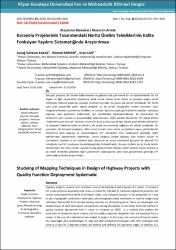Karayolu projelerinin tasarımındaki harita üretim tekniklerinin kalite fonksiyon yayılımı sistematiğinde araştırılması
Künye
Kalak, A. , Erbıyık, H. & Can, E. (2020). Karayolu Projelerinin Tasarımındaki Harita Üretim Tekniklerinin Kalite Fonksiyon Yayılımı Sistematiğinde Araştırılması . Afyon Kocatepe Üniversitesi Fen Ve Mühendislik Bilimleri Dergisi , 20 (5) , 951-962 . DOI: 10.35414/akufemubid.713248Özet
Karayolu projeleri, bir ülkenin kalkınmasında ve gelişmesinde çok önemli bir rol üstlenmektedir. Bu tür
ulaşım ile ilgili mühendislik projelerine altlık olarak hizmet veren harita ve planların doğru olarak
üretilmesi; yolculuk güvenliği, yolculuk emniyeti açısından da ayrıca çok önemli olmaktadır. Bir harita
veya plan yapımında genel olarak jeodezik ya da yersel (topografik) üretim teknikleri, hava
fotogrametrisinden yararlanma teknikleri ve uzaktan algılama (uydu görüntüleme) uyduları vasıtasıyla
sağlanan uydu görüntüsü kullanımıyla ilgili tekniklerden faydalanılmaktadır. Bu yöntemlerin de
birbirlerine göre avantaj ve dezavantajları bulunmaktadır. Diğer yandan literatürde KFY olarak bilinen
“Kalite Fonksiyon Yayılımı” yöntemi, seçilen bir konu ya da proje ile ilgili olarak, proje teknik kriterlerinin
ve projeden beklenen kalite ölçütlerinin bir arada incelenmesini sağlayan bir teknik olmaktadır. Bu
çalışmada, bir karayolu projesine, altlık olarak hizmet veren harita ve planların yapım yöntemlerinin
birbirlerine göre avantaj ve dezavantajların KFY tekniğinde nasıl incelenmesi gerektiği, işlem
adımlarından bahsedilerek anlatılmıştır. Ayrıca karayolu projesi talepçisi olan müşteri kurum ve
kuruluşların, istekleri ve bu isteklere bağlı olarak da ve ayrıca uzmanların görüşleri de alınarak KFY
tekniğinde nasıl bir korelasyon kurulabileceğinden bahsedilmiştir. Bununla birlikte bu üç harita üretim
yönteminden biri olan uzaktan algılama (uydu görüntüleme) metodu hedef yöntem olarak seçilmiş ve
bu hedef yöntemin gelecekte diğer yöntemlerin avantajlarına göre nasıl geliştirilmesi gerektiği KFY
sistematiği içerisinde araştırılmıştır. Highway projects, assume very important roles in development and progress of a nation. To produce the maps and plans accurately that serves as a base for this kind of transport engineering projects; will also be very important in terms of transport safety, and transport security. In the production of a map or plan; topographic production techniques, air photography using techniques or satellite image using technique that benefit from remote sensing satellites are utilized in general. There are advantages and disadvantages of these techniques comparatively among themselves. On the other hand, the method of quality function deployment that is known in literature as ‘QFD’, is a method that enables the evaluation of project technical criteria and the quality objectives altogether that are expected from a project in the case of a selected certain subject or project. In this study, the necessity of how to review the advantages and disadvantages of map and plan production techniques with QFD technique that serve as a basis for a highway project, are defined with defining the operation stages. In addition, it is also mentioned about how to establish a correlation in QFD technique by receiving the expert opinions for meeting the demands of the companies and organizations for fulfilling their highway projects requirements. However, among one of those three map production methods “remote sensing” is selected as target method, and it is mentioned in the operation stages of the QFD systematic as how to improve this target method in the future by considering the advantages of the other methods.
Kaynak
Afyon Kocatepe Üniversitesi Fen Ve Mühendislik Bilimleri DergisiCilt
20Sayı
5Bağlantı
https://dergipark.org.tr/tr/download/article-file/1033063https://doi.org/10.35414/akufemubid.713248
https://hdl.handle.net/11630/9549
Koleksiyonlar
- Cilt 20 : Sayı 5 [20]



















